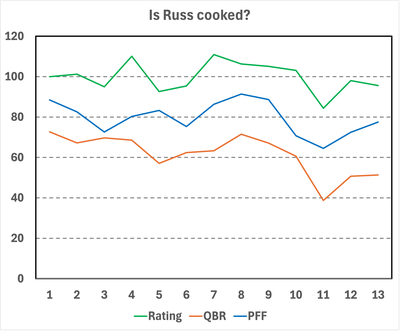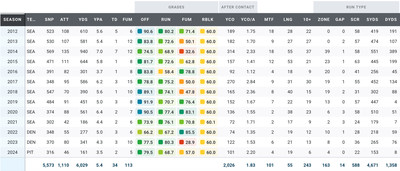
With all the coaching changes it’s hard to tell
It was only a week or so ago that Tommy DeVito was the only quarterback on the the New York Giants’ roster. Then in fairly rapid succession, the Giants signed both Jameis Winston and Russell Wilson to contracts. Given Wilson’s more illustrious career, which includes one Super Bowl ring and almost a second, it is assumed by most people that he will be the Giants’ starter in 2025. In reality, we’ll have to wait until training camp to know for sure, since both QBs started part of the season for their previous teams.
Winston, at 31, is six years younger than Wilson will be by mid-season. Winston’s problem has always been that his prolific passing game, which includes two 4,000-yard seasons and one 5,000-yard season, has been offset by his proclivity for interceptions. Wilson has never had that issue. The question with Wilson, given his age, is whether he is nearing the end of the line, considering that after spending 10 years with the team that drafted him, he is now on his fourth team in five years. How close is the Wilson the Giants are getting to the one who built a possible (probable?) Hall of Fame case for himself in his first decade in the NFL?
Here are three different measures of Wilson’s passing productivity over time by year:
- The traditional NFL passer rating, a subjective formula based on purely objective input statistics: pass attempts, completions, passing yards, touchdown passes, and interceptions
- The ESPN total quarterback rating (QBR), which is based on expected points added including passes and QB rushes, but with adjustments for the quality of defense faced and whether a play occurred in garbage time or not.
- The Pro Football Focus passing grade, a subjective measure based on film analysis of each play and whether a quarterback did as much as expected, more, or less, considering also the game situation.
Passer rating is on a 0-158.3 scale while the other two range from 0-100, but for this discussion I care only about how Russell Wilson’s seasonal numbers have progressed over time. Here they are year by year:

Courtesy of Pro Football Reference, ESPN, and PFF
Right off the bat, let’s eliminate Year 11 (2022), Wilson’s first of two seasons in Denver, when first-time head coach Nathaniel Hackett was clearly in over his head and Wilson had his worst season ever by all three measures charted above. Even without that year, though, we can see that Wilson’s performance has declined over time, since about 2020 (Year 9).
The interesting thing about Wilson’s NFL career is that most of it has been spent with head coaches whose offense revolved around the run more than the pass. That was Pete Carroll’s calling card when he was head coach of the Seahawks, so much so that in 2019, fans began to implore him to “Let Russ Cook.” Indeed, by the measures of QBR and PFF passing grade, 2019 (year 8) was his best season. Carroll did let the offense revolve more around Wilson in 2020, but with less success that year and more so in 2021, which led to his trade to Denver. Giants fans will remember the game in Seattle in 2020, when Patrick Graham’s zone defense flummoxed Wilson and allowed the Giants to win in Seattle despite having Colt McCoy at quarterback.
Ironically, through the first two-thirds of his career, Wilson was one the NFL’s best running quarterbacks:

Courtesy of Pro Football Focus
Most of those years he was in the top 10 in rushing yards among non-QBs, including 2014, when he led the NFL with 940 rushing yards and had 7 rushing TDs. As the last two columns in the chart above indicate, a decent amount of that was on designed runs (last column), although Wilson was proficient at getting yards scrambling as well (second-to-last column). Those days are over, however – since 2019 Wilson has done little in the way of designed runs and his yards gained on scrambling have decreased as well. That will put a premium on the Giants’ offensive line getting back to its early 2024 season pass protection form when Andrew Thomas was healthy.
The most interesting story line for this season, though, is that it will be Wilson’s sixth season in a row in a different offense. He went from Brian Schottenheimer (2020) to Shane Waldron (2021) to Nate Hackett (2022) to Sean Payton (2023) to Arthur Smith (2014) in his previous stops. Wilson seemed ill-suited to Smith’s run-first philosophy in Pittsburgh. In principle Sean Payton should have been a better fit, but Wilson never seemed to be able to execute Payton’s offense the way Payton had been used to when he had Drew Brees. (Amazingly, Winston, who started for Payton for seven games in 2021 until he tore his ACL, was having the best season of his career, with 14 TDs and only 3 INTs, when he was injured.)
Brian Daboll simplified his offense for Daniel Jones. You have to believe that he is going to try to open up the playbook now that he has Wilson. Will Wilson be up to the task?